xxxxxAs we have seen, the Committee of Public Safety was established in April 1793 in the face of both external and internal threats. However, it did not really get down to work until June, when the moderate Girondist party, numbering 31 in the National Convention, was overthrown and replaced by the militant Montegnards, supporters of the left-wing Jacobite club and the Paris mob. The following month Maximilien Robespierre joined and became its leading figure. Work was then speedily put in hand to strengthen not only the country’s defences, but also the people’s resolve.
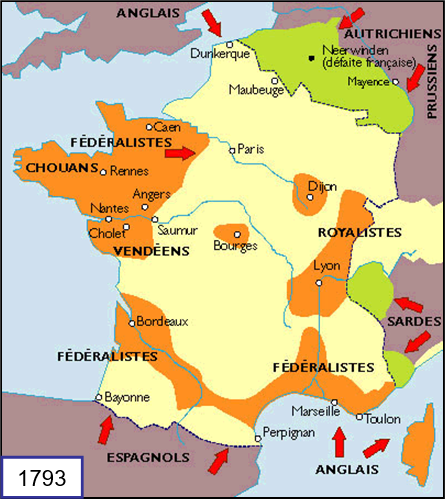 xxxxxThere was certainly much work to be done. In April a powerful coalition of monarchies had been formed, including Britain and Spain, to nip the new Republic in the bud. Within weeks the French had been driven out of the Austrian Netherlands and the Rhineland, and faced a Spanish invasion in the south. Due largely to the measures introduced by Lazare Carnot, a huge force of some 800,000 men was mobilised by compulsory military service, and fourteen well-equipped armies were put in the field to repel the invaders. But equally as threatening, if not more so, was the growing unrest in France itself. By June there were serious disturbances in a number of cities, particularly in Lyons, where the authority of the Convention was overthrown, and in Toulon, which had capitulated to the British and was held by them. In addition a number of areas in the country were seething with discontent and close to civil war, especially the regions of the Vendée and Brittany. The major reasons for these uprisings were the government take-over of the Catholic Church, and the introduction of universal conscription. In addition, a number of areas opposed the central control imposed by the revolutionaries, and came out in favour of a federal system of government. In the map of France above, the red arrows show the external dangers, the orange depicts the regions in revolt, and the green shows the areas lost by the French since their victory at the Battle of Valmy in September 1792.
xxxxxThere was certainly much work to be done. In April a powerful coalition of monarchies had been formed, including Britain and Spain, to nip the new Republic in the bud. Within weeks the French had been driven out of the Austrian Netherlands and the Rhineland, and faced a Spanish invasion in the south. Due largely to the measures introduced by Lazare Carnot, a huge force of some 800,000 men was mobilised by compulsory military service, and fourteen well-equipped armies were put in the field to repel the invaders. But equally as threatening, if not more so, was the growing unrest in France itself. By June there were serious disturbances in a number of cities, particularly in Lyons, where the authority of the Convention was overthrown, and in Toulon, which had capitulated to the British and was held by them. In addition a number of areas in the country were seething with discontent and close to civil war, especially the regions of the Vendée and Brittany. The major reasons for these uprisings were the government take-over of the Catholic Church, and the introduction of universal conscription. In addition, a number of areas opposed the central control imposed by the revolutionaries, and came out in favour of a federal system of government. In the map of France above, the red arrows show the external dangers, the orange depicts the regions in revolt, and the green shows the areas lost by the French since their victory at the Battle of Valmy in September 1792.
xxxxxIt was against this desperate background that the Committee of Public Safety, via the Revolutionary Tribunal, resolved to add another weapon to its arsenal - the instrument of terror. France was fighting for its life. Only by a programme of cleansing, it argued, could the republic be rid of its internal enemies, and the nation regain its resolve to fight. This bloody system of repression, enforced by “Representatives of the People”, sanctioned the arrest of any persons who were suspected of anti-revolutionary behaviour, and their execution by the guillotine following a summary trial. The Reign, which lasted ten months, started in earnest on the 5th September 1793, when an organized system of terror was made the order of the day in Paris and throughout the provinces.
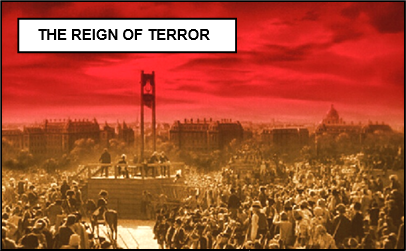
xxxxxThe first leader of the Committee was the Jacobin Georges Jacques Danton, and he was followed by Maximilien Robespierre in July 1793. Virtually a dictator, he further strengthened his hold on power in March 1794 when he eliminated the radical Hébertists, a political left-wing group which had attempted to spearhead a popular rising in Paris. Then later that month the moderate Danton, labelled an “indulgent” (a “softy”) also fell out of favour. Proposing a halt to the bloodbath, he was accused of disloyalty by Robespierre and sent to the guillotine. Then for the last 100 days Robespierre ruled alone, striving at this time to rally the revolutionary movement around a civic religion in what he termed a Republic of Virtue. But towards the end of July the blood letting was beginning to run its course, and, as the fervour subsided, there was growing public indignation over the excessive spilling of blood. Robespierre faced growing opposition to his rule in the National Convention and, with little or no improvement in living conditions, he also began to lose the country’s support. Furthermore, by his attack on the Hébertists he had reaped the wrath of the sans-culottes. On the 28th July he, in his turn, found himself on the way to the guillotine, followed by more than one hundred of his supporters.
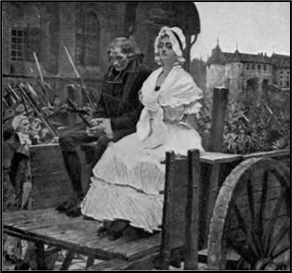 xxxxxDuring La Terreur, as the French came to call it, hundreds of men and women were executed in Paris alone, many on the slightest evidence. As one might expect, one of the first victims to be declared guilty and sent to the guillotine was the former queen Marie Antoinette. Like all those condemned to death, she was paraded through the streets of Paris in a tumbril (an open cart) (illustrated), en route for the place of execution at the Place de la Revolution (today’s Place de la Concorde). Here hundreds of people would be waiting to see the guillotine do its grisly work. But members of the nobility were by no means the only people to travel in the tumbrils. In fact, contrary to popular belief, it is estimated that less than 10 per cent of those executed were from the aristocracy. Indeed, soon after the execution of Marie Antoinette, 21 Girondists, political enemies of the Montagnards, were disposed of in this way, and a large number of the victims - some 14 per cent - were members of the clergy who refused to swear allegiance to the government. But by far the biggest proportion - nearly three-quarters - was made up of town workers or peasants who had been accused of desertion, draft-dodging, rebellion or hoarding food supplies. As noted earlier, one of the main aims of the Terror was to instill fear and obedience among the masses.
xxxxxDuring La Terreur, as the French came to call it, hundreds of men and women were executed in Paris alone, many on the slightest evidence. As one might expect, one of the first victims to be declared guilty and sent to the guillotine was the former queen Marie Antoinette. Like all those condemned to death, she was paraded through the streets of Paris in a tumbril (an open cart) (illustrated), en route for the place of execution at the Place de la Revolution (today’s Place de la Concorde). Here hundreds of people would be waiting to see the guillotine do its grisly work. But members of the nobility were by no means the only people to travel in the tumbrils. In fact, contrary to popular belief, it is estimated that less than 10 per cent of those executed were from the aristocracy. Indeed, soon after the execution of Marie Antoinette, 21 Girondists, political enemies of the Montagnards, were disposed of in this way, and a large number of the victims - some 14 per cent - were members of the clergy who refused to swear allegiance to the government. But by far the biggest proportion - nearly three-quarters - was made up of town workers or peasants who had been accused of desertion, draft-dodging, rebellion or hoarding food supplies. As noted earlier, one of the main aims of the Terror was to instill fear and obedience among the masses.
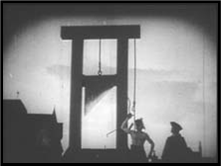 xxxxxEstimates of the numbers executed during the French Revolution vary widely. In Paris alone these range from 1,400 to 2,600. Taking into account the executions also taking place all over France at this time, the victims of the guillotine might be pitched in the region of 17,000, this figure not including the hundreds who died in prison awaiting “trial”. What is certain is that the bulk of these executions - probably more than half - took place in the June and July of 1794, the last two months of the reign, soon after a law passed by the Committee took away a suspect’s right to a public trial, and gave the tribunal a simple choice between acquittal and death.
xxxxxEstimates of the numbers executed during the French Revolution vary widely. In Paris alone these range from 1,400 to 2,600. Taking into account the executions also taking place all over France at this time, the victims of the guillotine might be pitched in the region of 17,000, this figure not including the hundreds who died in prison awaiting “trial”. What is certain is that the bulk of these executions - probably more than half - took place in the June and July of 1794, the last two months of the reign, soon after a law passed by the Committee took away a suspect’s right to a public trial, and gave the tribunal a simple choice between acquittal and death.
xxxxxBy the time the Reign of Terror had come to an end in July 1794, the revolutionary government had generally forced its will on the country as a whole. The reforms put in hand during the previous year had produced a fighting force of unprecedented size, and some of these troops had been used to quell unrest throughout the country. The cities of Lyon and Toulon, for example, had been retaken, and the uprisings in regions seeking autonomy under a federal state - like the Vendée and Brittany - had been largely crushed. And the tide had also been turned against the invader. The victory over the British at Hondschoote in September 1793, was followed by a defeat of the Austrians at the Battle of Wattignies the following month. Then in June 1794 the crushing of the Austrians at the Battle of Fleurus paved the way for the second conquest of the Austrian Netherlands, and a further attempt at an attack upon Holland. By this time, too, French forces had repulsed the Spanish in the south, and were advancing towards the Rhine in the north. In these battles the French had an advantage in that their larger force could endure heavy casualties and still mount a counter offensive. As we shall see, this series of French victories was to bring about the Treaties of Basle in 1795.
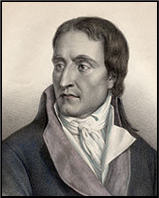 xxxxxIncidentally, not all the executions during the Reign of Terror were by the guillotine. In August 1793, for example, Jean-Baptiste Carrier (1756-1794) (illustrated), a member of the National Convention, was sent on a mission to Brittany (then in revolt), and two months later was ordered to save the city of Nantes from the insurgents in the Vendée. Here he devised a mass means of extermination known as the noyade (the drowning). Over three months he killed 2000 prisoners by loading them on to old vessels, taking the boats down the Loire, and then sinking them out at sea. Such barbarism was even too much for The Terror. When a reaction to the killing set in, he was accused of mass murder and sent to the guillotine. ……
xxxxxIncidentally, not all the executions during the Reign of Terror were by the guillotine. In August 1793, for example, Jean-Baptiste Carrier (1756-1794) (illustrated), a member of the National Convention, was sent on a mission to Brittany (then in revolt), and two months later was ordered to save the city of Nantes from the insurgents in the Vendée. Here he devised a mass means of extermination known as the noyade (the drowning). Over three months he killed 2000 prisoners by loading them on to old vessels, taking the boats down the Loire, and then sinking them out at sea. Such barbarism was even too much for The Terror. When a reaction to the killing set in, he was accused of mass murder and sent to the guillotine. ……
xxxxx…… Thexnoyade was doubtless an isolated incident, if only because of its scale, but there were plenty of atrocities committed across the country at this time. As Madame Marie Roland (1754-1793), the wife of the former leader of the Girondists, commented as she waited to be guillotined in November 1793: “O Liberty, what crimes are committed in thy name!” When her husband learnt of her execution he took his own life. Amongxthose sent to the guillotine were the outstanding French poet and political journalist André de Chénier, and the brilliant French chemist Antoine Lavoisier. ……
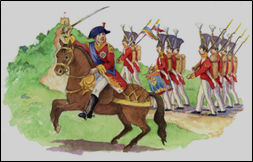 xxxxx…… It was during the Reign of Terror that, as a member of the coalition formed against the new republic, Britain sent an army to Flanders. Led by the Duke of York, Frederick Augustus, - a man not renowned for his military prowess - it won a cavalry skirmish at Beaumont in April 1794, but was then roundly defeated at Tourcoing the following month. The Duke was hastily recalled home where, unfortunately for him, his poor performance was recorded for posterity in the nursery rhyme The Grand Old Duke of York, the commander who marched his men to the top of the hill and then simply marched them down again. ……
xxxxx…… It was during the Reign of Terror that, as a member of the coalition formed against the new republic, Britain sent an army to Flanders. Led by the Duke of York, Frederick Augustus, - a man not renowned for his military prowess - it won a cavalry skirmish at Beaumont in April 1794, but was then roundly defeated at Tourcoing the following month. The Duke was hastily recalled home where, unfortunately for him, his poor performance was recorded for posterity in the nursery rhyme The Grand Old Duke of York, the commander who marched his men to the top of the hill and then simply marched them down again. ……
 xxxxx…… Andxit was during the public executions in Paris that a certain French woman named Marie Grosholtz (1761-1850), having learnt the art of wax modelling from an uncle, had the unenviable task of making death masks from the severed heads of those who had been guillotined - including those of Louis XVI and Marie Antoinette. Because she had worked as an art teacher to the royal family at Versailles, she was imprisoned for a time when the Revolution broke out, and it was then that she was assigned her gruesome task. Onxthe death of her uncle in 1794 she inherited two wax museums and, following the failure of her marriage to François Tussaud, a French engineer, she settled in England in 1802. Over the next 33 years she toured the British Isles with her exhibition of wax models - which included figures of Voltaire, Nelson and Walter Scott - and in 1835 eventually set up her museum, Madame Tussaud’s, in Baker Street, London. It was moved to its present site in Marylebone Road in 1884.
xxxxx…… Andxit was during the public executions in Paris that a certain French woman named Marie Grosholtz (1761-1850), having learnt the art of wax modelling from an uncle, had the unenviable task of making death masks from the severed heads of those who had been guillotined - including those of Louis XVI and Marie Antoinette. Because she had worked as an art teacher to the royal family at Versailles, she was imprisoned for a time when the Revolution broke out, and it was then that she was assigned her gruesome task. Onxthe death of her uncle in 1794 she inherited two wax museums and, following the failure of her marriage to François Tussaud, a French engineer, she settled in England in 1802. Over the next 33 years she toured the British Isles with her exhibition of wax models - which included figures of Voltaire, Nelson and Walter Scott - and in 1835 eventually set up her museum, Madame Tussaud’s, in Baker Street, London. It was moved to its present site in Marylebone Road in 1884.
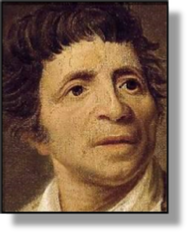 xxxxxOne of the most ardent enthusiasts for the Revolution, Jean Paul Marat (1743-93) played a part - albeit an indirect part - in bringing about the Reign of Terror, though he himself never lived to see its official beginning. He was trained as a physician but, as a writer, he published a number of books on a variety of subjects, including political theory and physics. His scientific writings led to his being honoured by the Royal Academy of Rouen in 1783, but he failed to be elected to the Academy of Sciences. This rankled with him, and might well account for his subsequent bitterness towards the establishment, already aroused by his reading of Montesquieu and Rousseau.
xxxxxOne of the most ardent enthusiasts for the Revolution, Jean Paul Marat (1743-93) played a part - albeit an indirect part - in bringing about the Reign of Terror, though he himself never lived to see its official beginning. He was trained as a physician but, as a writer, he published a number of books on a variety of subjects, including political theory and physics. His scientific writings led to his being honoured by the Royal Academy of Rouen in 1783, but he failed to be elected to the Academy of Sciences. This rankled with him, and might well account for his subsequent bitterness towards the establishment, already aroused by his reading of Montesquieu and Rousseau.
xxxxxWith the coming of the Revolution he found his forte when he turned his talent to journalism. His newspaper L’Ami du Peuple (The Friend of the People), first published in 1789, gained him a reputation as a vitriolic champion of the common people against their oppressors. Radical in the extreme, he called for the execution of a number of leading politicians, and strongly criticized the king himself, thus being obliged to seek refuge in England on two occasions. In September 1792 he lent support to the violent murder of political prisoners in Paris - the so called September Massacres - and on being elected to the National Convention became both feared and derided for his fanatical performance, and the vehemence of his oratory. His enemies, the moderate Girondists, brought political charges against him, but he was acquitted in April 1793, and, two months later, took his revenge by taking an active part in purging the Convention of his bitter rivals. This led to a powerful Jacobin government and paved the way for the Reign of Terror.
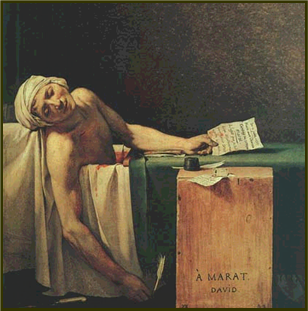
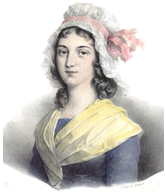 xxxxxItxwas Marat’s implacable opposition to the Girondists which led to his murder the following month at the hands of Charlotte Corday (1768-1793), a young woman from Caen, Normandy. Convinced that she had a divine mission to rid France of this fanatic, she gained admittance to his house on the 13th July by pretending to be an informer, and then stabbed him to death as he sat in his bath. This famous event was made the more famous later that very year, when the French painter Jacques Louis David captured the killing on canvas with his The Death of Marat (illustrated). Corday was arrested on the spot, and, needless to say, was sent to the guillotine four days later. Marat’s assassination was the cause of widespread public indignation. He was seen as a martyr to the people’s cause, thereby strengthening the power of the radicals, and hastening the dictatorship imposed by the Committee of Public Safety.
xxxxxItxwas Marat’s implacable opposition to the Girondists which led to his murder the following month at the hands of Charlotte Corday (1768-1793), a young woman from Caen, Normandy. Convinced that she had a divine mission to rid France of this fanatic, she gained admittance to his house on the 13th July by pretending to be an informer, and then stabbed him to death as he sat in his bath. This famous event was made the more famous later that very year, when the French painter Jacques Louis David captured the killing on canvas with his The Death of Marat (illustrated). Corday was arrested on the spot, and, needless to say, was sent to the guillotine four days later. Marat’s assassination was the cause of widespread public indignation. He was seen as a martyr to the people’s cause, thereby strengthening the power of the radicals, and hastening the dictatorship imposed by the Committee of Public Safety.



 xxxxxThere was certainly much work to be done. In April a powerful coalition of monarchies had been formed, including Britain and Spain, to nip the new Republic in the bud. Within weeks the French had been driven out of the Austrian Netherlands and the Rhineland, and faced a Spanish invasion in the south. Due largely to the measures introduced by Lazare Carnot, a huge force of some 800,000 men was mobilised by compulsory military service, and fourteen well-
xxxxxThere was certainly much work to be done. In April a powerful coalition of monarchies had been formed, including Britain and Spain, to nip the new Republic in the bud. Within weeks the French had been driven out of the Austrian Netherlands and the Rhineland, and faced a Spanish invasion in the south. Due largely to the measures introduced by Lazare Carnot, a huge force of some 800,000 men was mobilised by compulsory military service, and fourteen well-
 xxxxxDuring La Terreur, as the French came to call it, hundreds of men and women were executed in Paris alone, many on the slightest evidence. As one might expect, one of the first victims to be declared guilty and sent to the guillotine was the former queen Marie Antoinette. Like all those condemned to death, she was paraded through the streets of Paris in a tumbril (an open cart) (illustrated), en route for the place of execution at the Place de la Revolution (today’s Place de la Concorde). Here hundreds of people would be waiting to see the guillotine do its grisly work. But members of the nobility were by no means the only people to travel in the tumbrils. In fact, contrary to popular belief, it is estimated that less than 10 per cent of those executed were from the aristocracy. Indeed, soon after the execution of Marie Antoinette, 21 Girondists, political enemies of the Montagnards, were disposed of in this way, and a large number of the victims -
xxxxxDuring La Terreur, as the French came to call it, hundreds of men and women were executed in Paris alone, many on the slightest evidence. As one might expect, one of the first victims to be declared guilty and sent to the guillotine was the former queen Marie Antoinette. Like all those condemned to death, she was paraded through the streets of Paris in a tumbril (an open cart) (illustrated), en route for the place of execution at the Place de la Revolution (today’s Place de la Concorde). Here hundreds of people would be waiting to see the guillotine do its grisly work. But members of the nobility were by no means the only people to travel in the tumbrils. In fact, contrary to popular belief, it is estimated that less than 10 per cent of those executed were from the aristocracy. Indeed, soon after the execution of Marie Antoinette, 21 Girondists, political enemies of the Montagnards, were disposed of in this way, and a large number of the victims - xxxxxEstimates of the numbers executed during the French Revolution vary widely. In Paris alone these range from 1,400 to 2,600. Taking into account the executions also taking place all over France at this time, the victims of the guillotine might be pitched in the region of 17,000, this figure not including the hundreds who died in prison awaiting “trial”. What is certain is that the bulk of these executions -
xxxxxEstimates of the numbers executed during the French Revolution vary widely. In Paris alone these range from 1,400 to 2,600. Taking into account the executions also taking place all over France at this time, the victims of the guillotine might be pitched in the region of 17,000, this figure not including the hundreds who died in prison awaiting “trial”. What is certain is that the bulk of these executions - xxxxxIncidentally, not all the executions during the Reign of Terror were by the guillotine. In August 1793, for example, Jean-
xxxxxIncidentally, not all the executions during the Reign of Terror were by the guillotine. In August 1793, for example, Jean- xxxxx…… It was during the Reign of Terror that, as a member of the coalition formed against the new republic, Britain sent an army to Flanders. Led by the Duke of York, Frederick Augustus, -
xxxxx…… It was during the Reign of Terror that, as a member of the coalition formed against the new republic, Britain sent an army to Flanders. Led by the Duke of York, Frederick Augustus, - xxxxx…… Andxit was during the public executions in Paris that a certain French woman named Marie Grosholtz (1761-
xxxxx…… Andxit was during the public executions in Paris that a certain French woman named Marie Grosholtz (1761-
 xxxxxOne of the most ardent enthusiasts for the Revolution, Jean Paul Marat (1743-
xxxxxOne of the most ardent enthusiasts for the Revolution, Jean Paul Marat (1743-
 xxxxxItxwas Marat’s implacable opposition to the Girondists which led to his murder the following month at the hands of Charlotte Corday (1768-
xxxxxItxwas Marat’s implacable opposition to the Girondists which led to his murder the following month at the hands of Charlotte Corday (1768-

